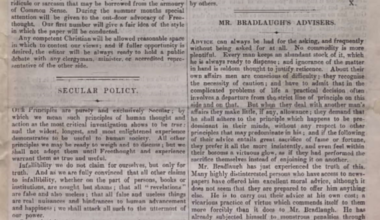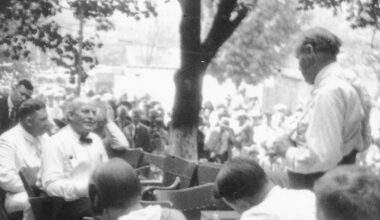
But I will dance to Tom Paine’s bones
Dance to Tom Paine’s bones
I’ll dance in the oldest boots I own
To the rhythm of Tom Paine’s bones
(Graham Moore, Tom Paine’s Bones, 1995)
To write one era-defining text would be enough for most of us. Thomas Paine wrote three. Born in Norfolk in 1737 in modest circumstances, Paine’s skill with a pen allowed him to give up his trade as a corset maker to become one of the most influential political writers of the eighteenth century, involved in both the American and French revolutions that rocked the Atlantic world and beyond.
Paine’s pamphlet Common Sense (1776), urging on American colonists in revolt against the British Crown, became an instant classic, denouncing monarchy in plain language and selling by the hundreds of thousands. His critique of hereditary power was sharpened further in Rights of Man (two parts, 1791–2), written in defence of the French Revolution and similarly fêted: Paine was briefly elected to the National Convention in Paris, despite not speaking French, although he later fell from favour and was imprisoned by the Jacobins. The last of Paine’s ‘big three’, The Age of Reason (three parts, 1794, 1795 and 1807) became his most controversial as he turned his critical gaze from monarchy and aristocracy to religion. The unabashed deism of that work alienated many of his Christian supporters, while at the same time inspiring a tradition of plain-speaking, irreverent critique of religion that in turn inspired the secularists and freethinkers of the nineteenth century, including the founder of this journal, G. W. Foote.
The best way to understand Paine’s enduring appeal is simply to read him. Despite its age, his language is easy to read, deliberately so. Paine told his readers what he thought, plainly but pithily, and published openly under his own name. No tortuous allegories, no classical pseudonyms, none of the methods authors of the time used to protect themselves. That brought trouble — Paine himself was persecuted, and his works were suppressed for decades in Britain, making a generation of booksellers and pamphleteers into political prisoners.
It also, however, brought fame and admiration. Paine’s bold openness was an invitation to every reader, however humble, to act likewise: to think for themselves and speak their minds. There was something special about Paine, that alongside his skewering of the powerful was a palpable love for his fellow human beings. In his own words, ‘My country is the world, and my religion is to do good.’ It was that inspirational humanity that led reformers in Britain and America to hold memorials every year on Paine’s birthday (29 January). It led the radical journalist William Cobbett to exhume Paine’s bones in New York to return them to his home country. Many years later, it inspired the folk musician Graham Moore to pen Tom Paine’s Bones, quoted at the beginning of this review. Centuries on, the old boy still commands attention from the grave.
We can now add Michael Bush’s Thomas Paine and the Polity of the Blood to that list. This is an academic work with a trick up its sleeve. On the face of it, it is a close scholarly study of Paine’s politics. Bush focuses on one principle — the rejection of hereditary power — that he takes to be central to Paine’s thought, his most original contribution to political debate. But read on, and you will realise something else is going on too. This is not just a book about Paine, it is a book about reading Tom Paine. About being inspired by Tom Paine. Finally, it is about coming to terms with the fact that Tom Paine is dead.
How does this work? Roughly the first half of Polity is taken up with Paine and his political works, especially Common Sense and Rights of Man. Having identified the heredity critique as pivotal to Paine’s thought, the second half of the book turns to its legacy. Despite his advocacy of republicanism in the United States and France, Paine and his disciples never managed to revolutionise his own mother country. Having given us a new intellectual biography of Paine’s thought, Polity’s second task is to write its obituary, recording how Paineism receded fitfully from prominence in British politics throughout the nineteenth century.
Taking these two halves in turn: in the first, Bush wants to secure Paine’s reputation not just as a canny populariser and polemicist, but as a profound and original thinker in his own right. Bush is firmly aligned with Jonathan Israel’s highly influential (and controversial) characterisation of there having been not one Enlightenment but two: one ‘Moderate’ (think John Locke, Voltaire or Adam Smith) and one ‘Radical’: Paine, Condorcet, Jefferson and others, all ultimately inspired by the seventeenth-century Dutch materialist Baruch Spinoza. To be ‘radical’ in Israel’s framework was not a matter of degree but about adherence to two specific propositions: democratic republicanism, coupled with the total rejection of religious authority.
Polity borrows that approach to give Paineism a core principle of its own, in the rejection of political heredity, from which the rest of Paine’s political thought flows. This involves considerable detective work: to prove originality involves working out what Paine was reading at any given time, who he met with socially, and what others had said before. This is the more impressive given Paine’s own persistent tendency not to cite sources. While generally convincing, at times this can seem a little reaching, as when a particular idea—that monarchy is illegitimate because future generations cannot be bound to contracts in perpetuity—is traced to John Locke specifically via Joseph Priestley, despite Bush conceding Paine never cited Priestley and only mentioned Locke to deny (albeit unconvincingly) having ever read him. Overall, though, this is a provocative, refreshing new view of Paine. While not downplaying his polemical importance, Polity is a lucid demonstration that Paine’s writings are just as fruitful for intellectual history as any of his better-heeled colleagues. In focusing on the origin of one core principle, Bush can identify subtle continuities and contrasts with earlier writers that have often been drowned out by the crash and din of the Revolutionary era.
At the same time, the focus on a single author and a single principle can lead to some unexpected inclusions and omissions. After the political philosophy, for example, the book gives a detailed publication history of Rights of Man: its various editions and reprints, their sales figures, and their vigorous suppression in the 1790s. On one hand, this provides Paine scholars a comprehensive resource on that work, and historians of eighteenth-century print will appreciate the detail on sales figures, exigencies of publication, and the practical business of getting radicalism before the public.
On the other, readers might fairly ask for context for such exhaustive detail, whether for Paine’s other works, especially the Age of Reason, which appeared shortly after and drastically altered Paine’s public reputation, or those by other authors. For those sales figures to really tell us something, we need to be told more about the literary marketplace of the time. That Paine’s Rights was just one contribution to a multinational ‘rights of man’ debate occasioned by the French Revolution is dealt with only very briefly. For instance Mary Wollstonecraft, whose feminist critique in A Vindication for the Rights of Woman (1792) would in time come to be one of the most enduringly influential works from that debate, comes and goes in a brief list of other authors. If Polity wants to examine not just Paine’s ideas but their enduring influence even after his death, we need to know more about their reception beyond state suppression.
This is especially so for authors like Paine, whose works could unite a readership in one moment yet divide it in another. Many fans of the republicanism in Rights simply could not follow him into the anti-religious sentiments in the Age. When Paine’s works were returned to circulation after the end of the Napoleonic Wars, mainly through the advocacy of the radical journalist-publisher Richard Carlile, Paine’s reputation changed again. Many of the Carlilean ‘infidels’ accepted Paine’s political principles but not his theological, not because his deism was too extreme, but because it was too mild compared to their own materialist atheism. Over the course of the 1820s, Britain’s Paineites ensured his name remained scandalous, associated with atheism and Jacobinism, such that many other radicals publicly distanced themselves from his principles: Henry Hunt, Major Cartwright, and even Cobbett himself.
Bush of course knows all this: his Friends and Following of Richard Carlile (2016) is the most detailed study to date of the rise and decline of Paineite agitation across the 1820s. There, we received a close study of how artisan agitators scattered around the country forged themselves into a national ‘infidel’ movement, united behind the publisher Richard Carlile’s efforts to keep Paine’s works in print. The second half of Polity is effectively the sequel to that study, jumping straight from Paine’s lifetime in the 1790s to a later resurgence in republican sentiments in Britain during the early 1830s.
In Paris, the July Revolution of 1830 had shown that popular resistance could overthrow a despotic monarch with little bloodshed. In Britain, the long-awaited Reform Acts of 1832 had been treated first with suspicion, then with outrage by radical campaigners. While abolishing the old Rotten Boroughs with only a handful of electors, and enfranchising the new industrial towns and cities, Earl Grey’s reforms fell far short of the universal manhood suffrage demanded by most radicals. The Reform Crisis seemed to confirm that, when push came to shove, even the nominally reformist Whigs were more interested in their own advancement, and maintaining order, than they were in enfranchising the working classes. The result was a renewed interest in radical reform: the question was, in what mode?
Having ploughed a lonely furrow through most of the 1820s, republicanism now seemed to have its moment. Carlile remained a vocal Paineite republican, albeit having undergone a personal religious journey that now saw him professing Christianity as an allegory for the martyring of human reason. Even former sceptics like Hunt and Cobbett seemed, if not converted, at least amenable to the idea that a republic might be achieved without a French-style Terror. Lastly, the 1820s had also given rise to social experiments in trades unionism, co-operative exchange, agrarian communitarianism, and socialism as sponsored by the industrial philanthropist Robert Owen. While these latter groups were all dissatisfied with the status quo, they were yet to be convinced that a Paineite republic was the answer for modern economic problems.
Polity narrates this brief republican juncture in gripping detail. Compared to the meticulous prose of the first half, this is social history that fairly rips along — expect covert meetings, spies and police brutality — and we get a strong sense of the personalities and egos in play. The view is very much from within the radical scene: only by getting up close can we understand how a generation of reformers, all united in disdain for the status quo, could so singularly fail to align their efforts to achieve change. Partly this was down to individuals, with Carlile particularly notorious for clashing with every other radical leader. But increasingly Paine’s ideas were showing their age. He might remain an inspirational figure, but in practical terms his writings against monarchs and priests offered little guidance in defending against the more invisible enemies of hunger and poverty in the age of capital. As Bush succinctly puts it, for many the ‘rights of man’ had been superseded by the ‘rights of labour’. There is a certain wistfulness to the portrayal: while republicanism has not disappeared from British politics, Paineism would never command such attention again.
That elegiac mood continues in the Appendix on the Bones. Bush takes up the question of what happened to Paine’s remains after Cobbett’s exhumation. Ever since then, they have been a metaphor for the fate of his ideas, perhaps misplaced but not forgotten. Parts of their subsequent trajectory have been known before, as they passed through various hands. Writers over the years have had a crack, but Bush claims the most complete answer yet as to where the bones likely reside. I shall not disclose the location here, but there is no cinematic ‘reveal’: no triumphant marble, no plaque, no humble grave marker awaiting at the end of the trail. But we knew that going in. Tom Paine was famed across the world, revered by generations of British reformers. If his name were engraved somewhere we would know it. There would be no mystery. Instead, we get a different kind of narrative, one that is about the looking, not the finding. The prose is palpably more relaxed, and the better for it, with Bush himself appearing in the text for the first time as he takes up the hunt.
Finding the bones would teach Bush nothing about Tom Paine he did not know already. But the fact that, two centuries on, people are still looking for them, teaches us something significant about Paine’s ability to reach across time like no one else. Cobbett dug. Carlile printed. Moore sang. Bush has read and looked and walked and written. And now, you can read this book.
Book details
Thomas Paine and the Polity of the Blood. With an Appendix on the Bones, by Michael Laccohee Bush, published by Mot Juste (May 2023)
More about Paine
All of Paine’s works are freely available online here.
Peter Linebaugh’s Red Round Globe Hot Burning (2019) uses a similarly personal author’s journey to explore the era of Atlantic revolutions, failed and successful, through the lives of Ned and Kate Despard.
Listen to: this recent cover of Tom Paine’s Bones, by Trials of Cato.








1 comment
‘Cobbett dug. Carlile printed. Moore sang. Bush has read and looked and walked and written. And now, you can read this book.’
What a great conclusion to a wonderful review of an important book. Paine and his ideas just won’t go away and inspire every generation, whether they realise it or not.
Your email address will not be published. Comments are subject to our Community Guidelines. Required fields are marked *
Donate